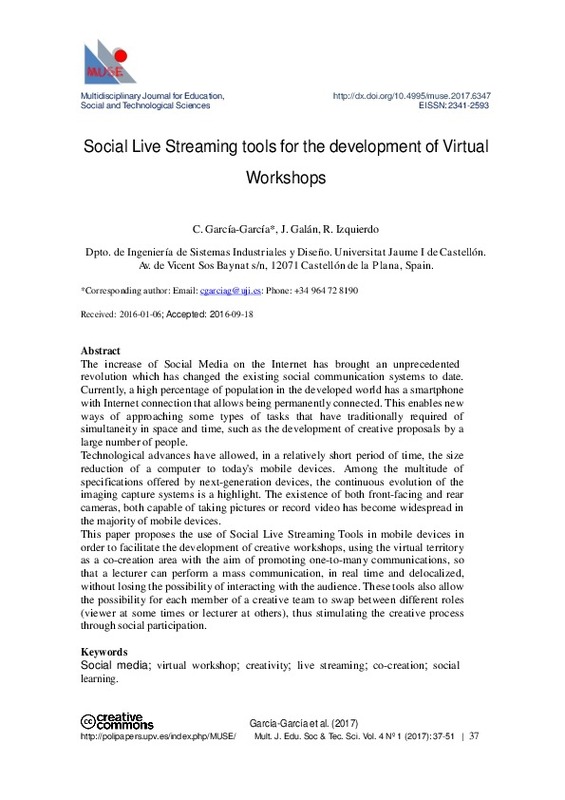Adell, J. and Casta-eda, L. (2010). Los Entornos Personales de Aprendizaje (PLEs): una nueva manera de entender el aprendizaje. In Roig Vila, R y Fiorucci, M (Eds). Claves para la investigación en innovación y calidad educativas. Roma: Marfil.
Banks, M. (2010). Craft labour and creative industries. International Journal of Cultural Policy, 16(3), 305-321. doi:10.1080/10286630903055885
Baser, J. A., Hasan, A., Sulaiman, J., & Buntat, Y. (2013). Informal Learning Model for Engineering Technology Teachers. Advanced Science Letters, 19(12), 3730-3732. doi:10.1166/asl.2013.5240
[+]
Adell, J. and Casta-eda, L. (2010). Los Entornos Personales de Aprendizaje (PLEs): una nueva manera de entender el aprendizaje. In Roig Vila, R y Fiorucci, M (Eds). Claves para la investigación en innovación y calidad educativas. Roma: Marfil.
Banks, M. (2010). Craft labour and creative industries. International Journal of Cultural Policy, 16(3), 305-321. doi:10.1080/10286630903055885
Baser, J. A., Hasan, A., Sulaiman, J., & Buntat, Y. (2013). Informal Learning Model for Engineering Technology Teachers. Advanced Science Letters, 19(12), 3730-3732. doi:10.1166/asl.2013.5240
Cenich, G., and Santos, G. (2006). Aprendizaje colaborativo online: indagación de las estrategias de funcionamiento. TE & ET, 1(1), pp. 1-8.
Chulvi, V., Mulet, E., Felip, F., and García-García, C. (2016). The effect of information and communication technologies on creativity in collaborative design. Research in Engineering Design, pp. 1-17. https://doi.org/10.1007/s00163-016-0227-2
Couldry, N. (2012). Media, society, world: Social theory and digital media practice. Cambridge: Polity Press.
Galán, J., García-García, C., Díaz, D., Mu-oz, A., and Pesudo, M. C. (2014). Use of videos and graphic tablets in the teaching-learning processs for handmade rendering in the degree in industrial design and product development engineering. Proceedings of 8th International Technology, Education and Development Conference (INTED 2014), pp. 6860-6868.
García-García, C., Galán Serrano, J., & Izquierdo Escrig, R. (2016). THE USE OF SOCIAL MEDIA AS A TOOL FOR POSITIONING THE PERSONAL BRAND OF STUDENTS IN THE DEGREE OF INDUSTRIAL DESIGN AND PRODUCT DEVELOPMENT ENGINEERING. INTED2016 Proceedings. doi:10.21125/inted.2016.1754
Hart, J. (2011). Social Learning Handbook: A Practical Guide to Using Social Media to Work and Learn Smarter. Corsham, Wiltshire: Center for Learning and Performance Technologies.
Mills, G. E. (2000). Action research: A guide for the teacher researcher. New Jersey: Prentice-Hall, Inc.
Pérez Ortega, A. (2006). Cómo destacar sobre la multitud. La marca personal. In Briones, J. L., (ed.) Marketing Creativo, Tomo 2 Colección Emprender en el Siglo XXI. Sevilla: Emergia, pp. 1-21.
Prahalad, C. K., & Ramaswamy, V. (2004). Co-creation experiences: The next practice in value creation. Journal of Interactive Marketing, 18(3), 5-14. doi:10.1002/dir.20015
Ritzer, G. (2013). Prosumption: Evolution, revolution, or eternal return of the same? Journal of Consumer Culture, 14(1), 3-24. doi:10.1177/1469540513509641
Rugg, A., and Burroughs, B. (2016). Periscope, Live-Streaming and Mobile Video Culture. In Lobaro, R. and Meese, J. (Eds) Geoblocking and global video culture. Amsterdam: Institute of Network Cultures, pp. 64-72.
Stewart, D. R. «Chip», & Littau, J. (2016). Up, Periscope. Journalism & Mass Communication Quarterly, 93(2), 312-331. doi:10.1177/1077699016637106
[-]








